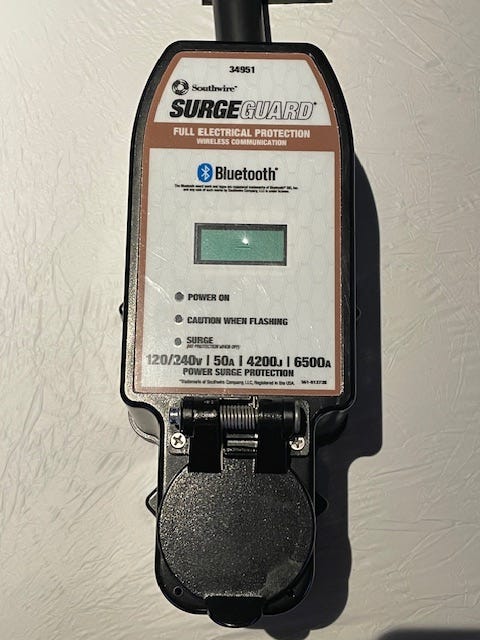Voltage: How high is too high?
The campground tells us 135 to 138 volts is okay. Should we be worried?
Dear Mike,
We are at a state park, it’s a brand new section they just finished up…we hooked our 50 amp surge protector and it flashes red and says voltage is high one leg says 136 and the other said 138. Park maintenance guy came and checked it said our surge protector is bad he also confirmed 136/138 said no big deal.
Neighbor is hooked up to 30 amp and brought his surge protector over checked our 30 and it said it was good. We went home and got our 30 amp SP it says the 30 amp is high 135 we checked with a multi meter inside camper and it says 135.2. The campground keeps saying people have camped no problems.
When we went home we plugged our Surge Protector into our 50 amp and it works just fine. We have Southwire surge protectors that test for high and low voltage.
Should we be worried? - H.V.
Dear H.V.,
Oh yes, 136 to 138 volts is way too high and will likely cause damage to many of your AC-powered appliances. In the United States and Canada, national standards specify that the nominal voltage at the source should be 120 V and allow a range of 114 V to 126 V (RMS) (−5% to +5%). However, these numbers are a bit more relaxed for campgrounds, so most engineers consider anything below 105 volts and above 128 volts at the pedestal to be out of the safe range.
It’s them, not you!
There’s nothing wrong with your Surge Guard unit. It’s doing exactly what it’s supposed to do, protect your RV from high and low voltages.
What can happen?
Low voltage is not really dangerous for your appliances that have world power supplies rated for 100 to 250 volts. So your laptop computer power supply, cell phone charger, and anything with a wall wart charger should be okay. However, air conditioners do draw more amperage once they get less than 110 volts, and compressor damage can result with less than 105 volts.
High pedestal voltage (over 128 AC volts) can damage your microwave oven, cause excessive current draw in your electric water heater element, and is also bad for air conditioner and residential refrigerator compressors. I’m not sure about inverter/chargers, but I’m reasonably confident that higher voltages will cause eventual component damage. I’ll ask my engineering colleagues at WFCO and Progressing Dynamics for any data they have on this topic.
They boost voltage for the eventual voltage sag from overburdened power distro
The real problem is that when many campgrounds were built, there was much less demand for a lot of power from RVs. But now everyone has at least one or two air conditioners, a refrigerator, lithium battery charger, etc…. So to avoid having the voltage sag too low in the afternoon, they have the local power company reset the taps on the incoming transformers to boost the voltage enough so that it won’t sag as low when everyone turns on their air conditioners.
Don’t accept high-voltage
While it would be possible to build an automatic buck/boost transformer that would keep the voltage within limits, even the Hughes Autoformer only does a 10% boost during low voltage conditions. It can’t reduce incoming voltage. So trust your Surge Guard unit when it shuts off the incoming high-voltage, and run off of batteries until the campground voltage drops enough during the afternoon so you can run your air conditioner.
Let’s play safe out there… Mike







Mike. Thanks. Great article
I have written this before but my Progressive Industries hard wired surge protector detected volts of 136 at my house a number of years ago. I called the power company and they checked it out. It was a problem at their substation.